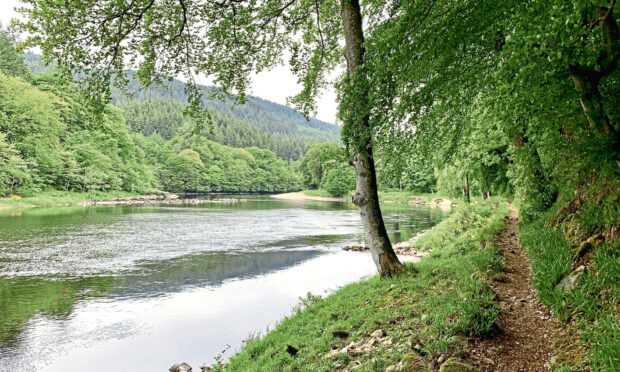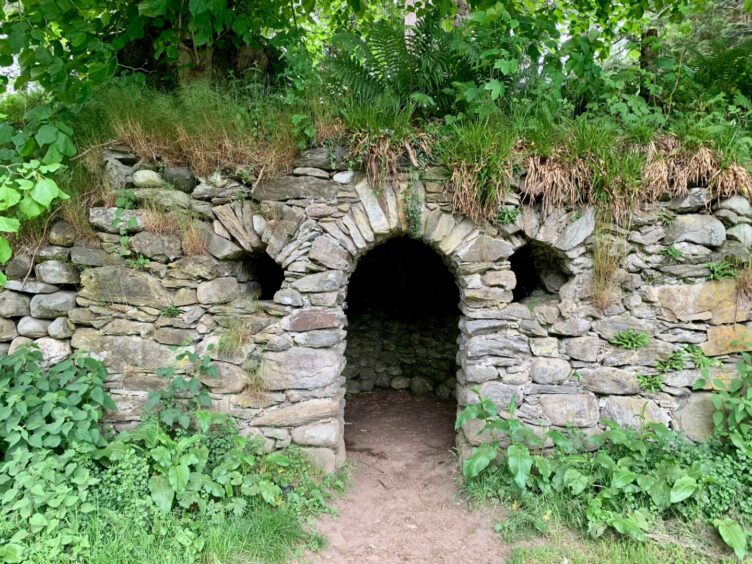It’s easy to see why Dunkeld was recently voted the best place in Scotland to live – a picture postcard setting, beautiful buildings and a fine selection of individual shops and eateries.
It’s also a grand base for a wide variety of walks for all ages and abilities, offering rough little hills, stunning lochs and woodland and river paths.
The Fiddler’s Path is a low-level circuit around the banks of the Tay that all the family can enjoy. It’s long enough to satisfy the adults and has enough points of interest to keep the youngsters happy for a couple of hours.
From the back of the car park off Atholl Street, a signed path leads round the foot of Stanley Hill to the cathedral, an imposing building of mixed architectural influences dating from the early 14th Century. The grounds are open to the public but there are some restrictions for the building itself due to restoration investigative work.
The path heads right then turns left past the tower into woodland. Here you will find the massive Parent Larch, the only remaining one of five European larches imported by the Duke of Atholl in 1738. The seeds from these huge trees helped expand the forest cover throughout the county over the following years.
Our route then goes through the trees – the kids will love measuring themselves against the width of some of the fallen giants or counting the rings – before heading down to the Tay.
The route sticks closely to the water, although there are a few choices along the way. At the first split, the lower route along a narrower path is the better option with an intricate stone grotto to investigate.
Further on, after passing Dunkeld House Hotel, the lower option is again the better one, swapping the surfaced track for a narrow path close to the water. When it reaches a fisherman’s beat signed Rock Pool, turn right on a track heading uphill to rejoin the main track.
The one downside comes at the midway point of the walk. After passing under the Jubilee Bridge, the signs take you up to the busy A9 and the walkway crossing the bridge with the traffic thundering past. Thankfully, it’s short-lived and you are soon back into the woods heading down the other side of the Tay.
As if in recompense, this next section is even more serene and picturesque, the path twisting through thick, verdant tree cover with swathes of wild flowers, attended by noisy birdlife and butterflies. It goes through tunnels, up steps and over bridges and streams, then passes a ruin long surrendered to the forest before dropping back to the river.
Here is the inspiration for the walk: a massive tree known as Niel Gow’s Oak, where the man regarded as the father of Scottish fiddle music was said to have sat and composed many of his works. An ornamental bench beside the tree is decorated with some of his lyrics.
Gow, who lived in the adjoining settlement of Inver until his death in 1807, was a favourite of the Dukes of Atholl and knew Robert Burns, who was said to have used several of Niel’s tunes for his songs. Dunkeld continues to host an annual festival in his name.
The final leg of the journey takes a detour to cross the River Braan before heading under the Tay Bridge and back into Dunkeld.
Fiddler’s Path Route
- Take path at back of car park (signed for Cathedral and Fiddler’s Path) which goes round foot of Stanley Hill. When path forks, go right to cathedral.
2. Turn right alongside iron railings enclosing cathedral grounds and at far end go left at junction signed for Fiddler’s Path.
3. Head upriver and when path splits take left branch which sticks closer to water passing stone grotto (both routes join further on). Continue close to river to pass Dunkeld House Hotel.
4. When path forks again, signed route continues straight ahead on tarmac but it’s better to follow narrow fisherman’s path going left. When you reach area signed as Rock Pool, take winding track back uphill to rejoin main route.
5. Continue on track to pass beneath Jubilee Bridge and a short distance further on, turn right at signed junction (Fiddler’s Path) which leads to A9. Turn right to cross road bridge, and at far side of walkway go right at minor road then right again on signed path into trees.
6. After passing under rail line then A9, go left at path fork and keep following river. Path turns inland to pass a ruin then heads back to riverside, leaving woods and following field edge.
7. Pass Niel Gow’s Oak then cross stream. Turn right at marker and pass under A9, then left on bridge over River Braan.
8. Once across, leave Fiddler’s Path to go left alongside river until reaching the Tay where path leads to Tay Bridge. Pass underneath and turn right up steps, then cross bridge back into Dunkeld.












